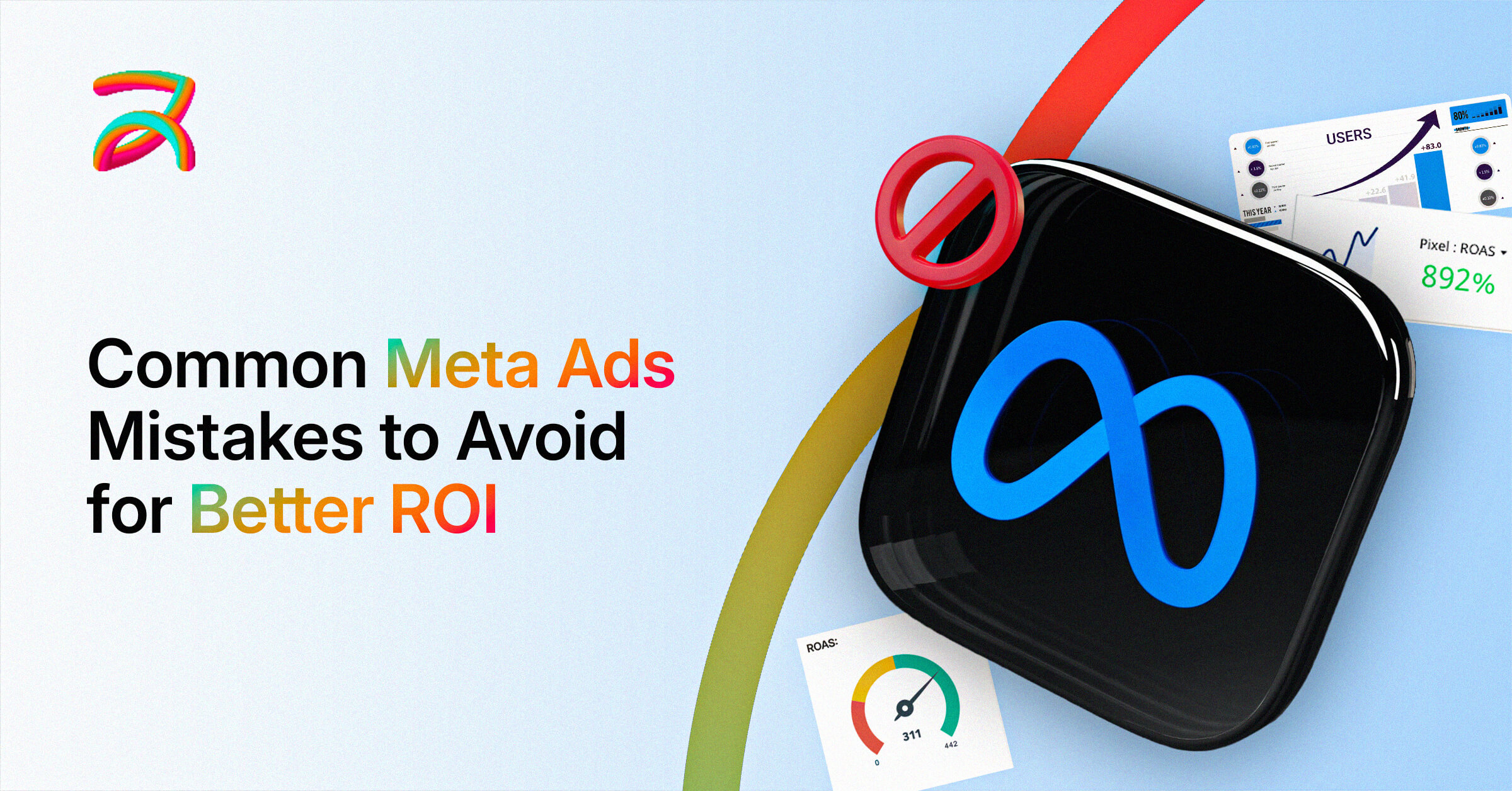We all know that Meta ads have the potential to bring the business growth you need to propel, but many marketers fall into common pitfalls that can cost them.
The saying, “The one who learns the work can do it,” fits here because, without learning how to avoid these mistakes, it can burn your budget and waste your time, essentially throwing your money down the drain.
When it comes to Meta Ads, learning from mistakes is key to success. 59% of Meta ad campaigns fail due to poor targeting or lack of optimization. The good news? You don’t have to learn the hard way, because we are here to save the day.
In this blog, we will walk you through the most common Meta Ads mistakes, how to avoid them, and how to ensure your ads work efficiently for better results and a stronger ROI.
📌 Tired of wasting budget on Meta Ads that don’t perform? Book a free consultation with our experts at Buzzz. We’ll review your campaigns, pinpoint costly mistakes, and help you unlock better ROI.
Book Your Free Consultation →Why Avoiding Mistakes in Meta Ads is Crucial for Better ROI
Common mistakes in Meta Ads can hurt your ROI by wasting your budget on poorly targeted ads or ineffective creatives. These missteps can prevent your campaigns from reaching the right people and achieving the results you want. Learning from these mistakes and optimizing your ad strategies is key to improving performance.
Benefits of Avoiding Meta Ads Mistakes:
- Improved ad performance leads to higher engagement and conversions.
- Optimized campaigns increase the chance of a better ROI on future ads.
- Reduced budget wastage ensures your ad spend is used effectively.
- Better targeting means reaching the right audience at the right time.
Common Meta Ads Mistakes to Avoid
Running Meta ads can trip you up, especially when you start out. Most costly mistakes? You can avoid them once you know what to look for. We’ve all done it.
Burned through the budget on ads that don’t convert. Targeted the wrong people completely. Here’s what goes wrong most often, so you can skip the headaches and start getting real results from your ads.
Mistake #1 – Poor Targeting and Audience Segmentation
You can’t just throw your ads at everyone and hope something sticks, but Meta’s tools help you reach your ideal right audience. Start with demographics (like age and location), target interests that match your product, and install the Meta Pixel to track site visitors and build custom audiences.
Then use lookalike audiences to find more people like your best customers. With the right audience, everything else performs better.
Here are some DOs and DON’Ts to follow:
| Poor Targeting Mistakes | Best-Practice Segmentation |
| Using broad demographics (e.g., “Men, 18–65+”) leading to low relevance and engagement | Layer interests, behaviors, and demographics for precise segments (e.g., “Men 25–34 interested in fitness gear”) |
| Not leveraging Meta Pixel data means missing out on high-intent site visitors or past purchasers | Build Custom Audiences from Pixel events (e.g., cart abandoners, purchase completers) and Lookalike Audiences |
| Single audience used across all campaigns, causing ad fatigue and wasted spend | Create separate campaigns/ad sets for cold, warm, and hot audiences with tailored messaging and creative |
| Ignoring performance data, running static segments even when CTR/CPA drifts | Continuously A/B test and refine segments based on performance metrics (e.g., swap out low-CTR interests monthly) |
| One-off audience setup with no ongoing optimization | Schedule regular audience audits (e.g., quarterly) and refresh segments based on the latest user behavior and trends |
Mistake #2 – Incorrect Budget Allocation
Setting the wrong budget can wreck your campaigns before they start. Too little money? Your ads barely get shown. Too much, too fast? You burn through cash without learning what works.
Start with smaller daily budgets and scale up gradually. Watch your ROI closely through Meta Ads Manager. Some campaigns need more budget to gather enough data.
Others perform better with budget caps to control spending. Test different budget settings to find your sweet spot. Remember, it’s not about spending more. It’s about spending smart on what converts.
Mistake #3 – Ignoring Mobile Optimization
Most people see your ads on their phones. If they don’t look good on mobile, you will lose potential customers fast. Mobile users scroll quickly; that’s why your ad has to grab attention instantly.
Check how your ads appear on different screen sizes. Text should be easy to read without zooming, videos should load fast and look sharp, and landing pages must work flawlessly on mobile.
“If you’re not designing for mobile, you’re not designing for most of your audience.” – Luke Wroblewski, Product Director at Google and pioneer of mobile-first design. Mobile-first isn’t optional anymore. It’s the difference between ads that convert and ads that get ignored.
Mistake #4 – Overcomplicating Ad Creatives
Simple wins every time, and that’s why complicated ads confuse people and make them scroll away. You don’t need fancy graphics or ten different messages in one ad.
Focus on one clear benefit with simple, conversational copy and a clean design that highlights your main point to avoid visual clutter from too many colors, fonts, or elements.
People should instantly understand what you are offering and why they need it. Creative simplicity makes your message more persuasive and memorable.
Mistake #5 – Failing to Test and Optimize Campaigns
“Set it and forget it” doesn’t work with Meta ads, and it shouldn’t be your practice either. You need to constantly test different versions to improve performance. A/B testing lets you compare ad creatives, headlines, and audiences to see what works best.
Try different images, change your copy, or test new target groups. Meta Ads Manager shows you which versions get better results. Use that data to optimize your campaigns.
Split testing takes time, but it’s how you turn good ads into great ones. Keep iterating and improving based on real performance data.
Strategies for Improving Meta Ads ROI by Avoiding Common Mistakes
Now that you know what goes wrong, let’s fix it. Smart strategies can turn your struggling campaigns into profit machines. You don’t need to be a marketing genius to get better results.
Focus on the basics first. Target the right people, optimize for mobile, and keep testing what works. Small changes often create big improvements in your ROI.
Strategy #1: Refine Audience Targeting for Better Engagement
Stop wasting money on people who won’t buy from you. Use Meta Pixel data and audience behavior to reach those most likely to convert. Target smarter, not broader, for better results and higher ROI.
- Reach people already interested in your product (custom audiences)
- Find new customers similar to your best ones (lookalike audiences)
- Show more relevant ads based on user behavior
- Boost engagement and drive more sales
Strategy #2 – Set Realistic Budgets and Optimize Spend
Your budget should match your goals, not your wishful thinking. Start small and scale up based on what works. Check your cost-per-click regularly through Meta Ads Manager. High CPC might mean your audience is too competitive or your ads need work.
Move money from underperforming campaigns to winners. Don’t spread your budget too thin across too many ad sets. Focus your spending on campaigns that convert. Track your ROI closely and adjust spending based on real results, not gut feelings.
Strategy #3 – Mobile-Optimize Ads for Maximum Reach
If your ads don’t look great on a phone, you’re already losing. These days, most people scroll social media on their phones not laptops. So if you’re using or offering a social media marketing service, designing for mobile first isn’t just smart it’s essential.
Stick to vertical or square images that fill the screen and catch attention. Keep your text big enough to read easily (nobody wants to squint). And before you launch, test how your ads look on different devices what looks good on a desktop might flop on mobile.
Don’t forget your landing pages, either. Even the best ad can’t save a slow-loading mobile page. Quick load times and mobile-first design make all the difference when it comes to clicks and conversions.
Strategy #4 – Keep Ad Creatives Simple and Engaging
One message, one goal, one clear action. Don’t try to say everything in one ad. Pick your strongest benefit and focus on that. Your call to action should tell people exactly what to do next. Use clean designs that don’t compete with your message.
Bright colors and busy backgrounds distract from your main point. Write like you are talking to a friend, not giving a business presentation. Simple ads perform better because people understand them instantly. Clarity beats creativity every time; that’s why most businesses hire creative design services for better visuals.
Strategy #5 – Continuously Test and Optimize Your Campaigns
Good ads become great ads through testing. Try different headlines, images, and audiences to see what works best. A/B testing shows you real data instead of guesses.
Test one element at a time so you know what caused the improvement. Run tests long enough to get meaningful results.
Check your campaign analysis regularly and pause what isn’t working. Move the budget to winning variations. Small improvements add up to big ROI gains over time. Never stop testing and improving your ads.
Final Thoughts
Meta Ads success comes down to avoiding simple mistakes and staying consistent with optimization. Target the right people, set smart budgets, optimize for mobile, keep creatives simple, and test everything.
If you need expert guidance, a Meta Ads agency can help you get the best out of your campaigns with high ROI. These aren’t complicated strategies, but they work. Start with one campaign and apply these tips. Track your conversions and ROI closely.
Small changes create big improvements in ad performance. Your next campaign can be your most profitable yet. Stop making these common mistakes and start seeing real results from your Meta Ads.
📞 Book a Call with a Meta Ads Specialist
Want to turn Meta Ads into predictable revenue? Connect with a certified specialist from Buzzz and get a customized action plan designed to improve your ad performance and maximize ROI.
Let’s Get Started! →FAQs
1. What are the most common Meta Ads mistakes that affect ROI?
Some common mistakes include poor audience targeting, not testing ad creatives, irrelevant landing pages, over-complicating ads, and failing to optimize campaigns. These can result in wasted budget, poor performance, and low ROI.
2. How can I improve my targeting on Meta Ads?
To improve targeting, use Meta Pixel to track site visitors and build custom audiences. Utilize lookalike audiences to find people similar to your best customers and refine your audience based on performance data.
3. Why is mobile optimization so important for Meta Ads?
Most users see your ads on mobile devices. If they’re not optimized for mobile, you risk losing potential customers. Ensure your ad design is mobile-friendly, with readable text, fast-loading landing pages, and a responsive layout.
4. How do I avoid wasting money on underperforming campaigns?
Set realistic budgets, monitor performance regularly, and adjust your spending. Shift money from underperforming campaigns to those delivering better results. A/B testing and performance tracking can also help identify what’s working and what’s not.
5. What is the best way to test my Meta ads for better results?
Use A/B testing to compare different ad variations, such as creative, copy, and audience targeting. Test one element at a time to determine which change had the biggest impact on performance, and adjust accordingly.
6. How can I avoid ad fatigue with Meta Ads?
To avoid ad fatigue, regularly refresh your ad creatives and test new variations. Also, create separate campaigns or ad sets for different audience segments to keep the content fresh and relevant to each group.
7. What should I do if my Meta ads aren’t converting?
If your ads aren’t converting, first check your targeting and make sure your ad aligns with the landing page. Also, optimize your creatives for better clarity and appeal. Mobile optimization and testing new creatives can improve performance.
8. What does “budget allocation” mean for Meta Ads?
Budget allocation refers to how you divide your budget across different campaigns, ad sets, or placements. It’s essential to ensure your budget is spent efficiently, focusing more on campaigns that are performing well and scaling them gradually.
9. Why is it important to keep Meta Ads creatives simple?
Overcomplicating your creatives with too many messages or design elements can confuse the audience. Focus on one clear, simple message that drives action. Clean and simple designs tend to be more engaging and memorable.
10. How often should I review my Meta Ads campaigns?
Regularly monitor your campaigns, ideally once a week, to track performance and make adjustments. Frequent checks allow you to catch any issues early, optimize targeting, and adjust budgets for the best results.




